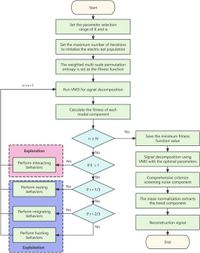A new method for processing and analyzing blasting vibration signals has been developed, which could transform how we monitor the effects of blasting in construction, mining, and other fields. This innovative technique combines variational mode decomposition (VMD) with an electric eel foraging optimization (EEFO) algorithm to effectively filter out unwanted noise and trends from vibration signals, leading to more accurate results.
Blasting is a common practice in various engineering projects, including tunnel excavation and mining, often generating vibrations that can negatively impact the surrounding environment and nearby structures. Accurate monitoring of these vibrations is crucial to minimize any potential damage. However, the vibration signals captured by monitoring equipment frequently contain complex noise and trends that obscure real readings, complicating analysis.
This study seeks to address these challenges by introducing a parameter-adaptive VMD method that employs the EEFO algorithm for optimizing crucial decomposition parameters prior to analysis. The importance of preprocessing blasting vibration signals cannot be overstated — without effective noise reduction and trend removal, vital characteristics of the vibrations may be lost, impairing analysis.
The researchers designed their method to remove high-frequency noise and low-frequency trend elements from vibration signal data. By developing a weighted multi-scale permutation entropy as the fitness function for the EEFO optimization process, they were able to enhance the precision of the decomposition parameters, including the number of modes and penalty factors.
Results demonstrate that the EEFO-VMD method significantly surpasses traditional techniques like empirical wavelet transform (EWT) and empirical mode decomposition (EMD) when it comes to adaptability in complex environments. "The analysis results of simulated vibration signals with different interference components... show that, compared to traditional VMD, empirical wavelet transform, and empirical mode decomposition methods, EEFO-VMD has superior adaptability and anti-aliasing capabilities," the authors stated.
Experiments conducted using both simulated signals with known interferences and real-world blasting signals from the Guanbaoshan Iron Mine in Liaoning Province, proved the method's efficacy. The VMD was able to process the contamination successfully, providing clearer and more accurate readings of the blasting vibrations.
For near-field measurements, where vibration signals often contain significant noise, the EEFO-VMD technique showed superior performance, clearly segregating meaningful vibration information from background interference. In contrast, traditional methods struggled, revealing how central this new technique could be for developing effective monitoring solutions in the future.
When comparing performance metrics, the results point to a marked improvement in the precision of blasting vibration signal decomposition using EEFO-VMD. "This method adaptively determines the optimal combination of decomposition modes K and the secondary penalty factor α," highlighted the research team, showcasing the algorithm’s focus on performance and reliability.
As blasting operations are frequently conducted in complex and noisy environments, this new approach recognizes the pressing need for advancements in signal processing techniques. Field-testing further validated that the EEFO-VMD method can reliably remove high-frequency noise and trend components, consequently enhancing signal clarity.
Given its demonstrated robustness, the new method is set to make a significant impact in blasting-induced vibration safety assessments. The implementation of optimized preprocessing techniques holds the potential for broader applications in vibration analysis across various engineering domains.
In summary, integrating an advanced signal processing technique like EEFO-VMD not only enhances accuracy but also ensures that the monitoring of vibration signals accurately reflects their true nature, leading to stronger safeguards against environmental hazards associated with blasting operations.

